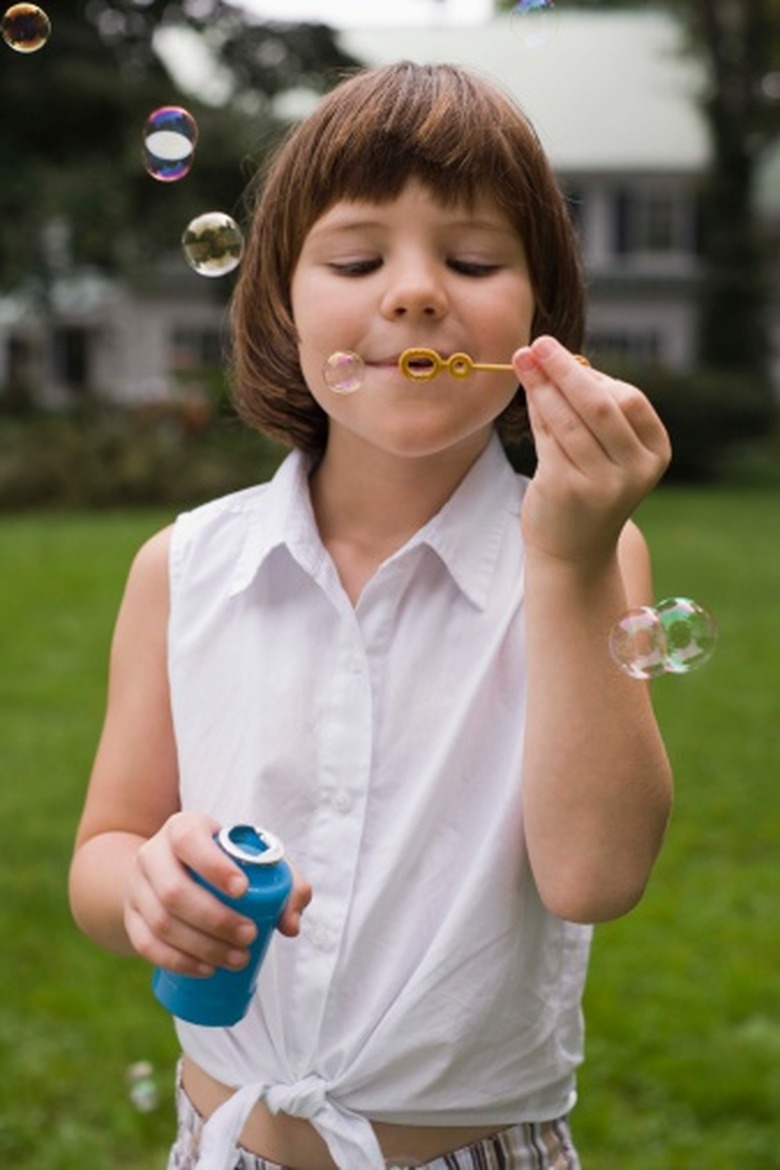Science Projects On Bubbleology
Playing with bubbles is a fascinating pastime for most children. Bubbles are colorful, easy to make and fun to pop. Bubbleology, or the study of bubbles, is a great way to combine science with play. Homemade bubbles require inexpensive household materials, and making these projects a simple and fun way to explore the science of bubbles at home.
About Bubbleology
About Bubbleology
Studying bubbles can be a fun and captivating science project. Bubbleology deals with exploring the properties of bubbles and why they behave like they do. The secret to making a good bubble is surface tension, a bond that holds water molecules together. When the surface tension of water is combined with a soap or detergent, it becomes elastic. This springy quality is what makes bubbles possible. Bubbles float because they are only slightly heavier than the air around them. If left unpopped, bubbles will pop on their own as the solution settles to the bottom of the bubble, making the top of the bubble too thin. Observing which ingredients make the best bubbles, how surface tension works and how bubbles are shaped are all aspects of bubbleology.
Bubble Brand Comparison
Bubble Brand Comparison
Have you ever wondered why some bubbles seem to pop right away while others seem to last forever? In this project, you will explore what brands of soap create the longest lasting (and most bubbly) bubbles. You will need four different brands of detergent or soap, water, four straws and four plastic drinking cups. Label the cups in accordance with each detergent brand. Fill each cup halfway with water and add 1 tablespoon of detergent or soap to each cup. Use the straws to blow bubbles in each cup and record how long the bubbles last on the surface before popping. The detergent with the most and longest lasting bubbles is the best for making bubbles.
Bubble Bomb
Bubble Bomb
To observe the surface tension of a bubble in action, create your own bubble bomb. This project can be messy and is best done outdoors. You will need water, a plastic zip-top sandwich bag, baking soda, paper towel, vinegar and a measuring cup. Pour 1/2 cup water into the sandwich bag and zip it shut. Turn the bag over to make sure it is free of leaks. Unzip the bag and empty it. Cut the paper towel into a 5-inch square and put 2 tablespoons baking soda in the center of the square. Fold the square into thirds (like a business letter or pamphlet). Pour 1/2 cup vinegar and 1/4 cup water into the sandwich bag. Add the packet, zip the top and place on the ground. Stand back and watch your bubble bomb gain tension until it explodes.
Different Shaped Bubbles
Different Shaped Bubbles
Have you ever seen a bubble in any shape besides a sphere? This experiment will attempt to create bubbles in a variety of shapes. For this project, you will need bubble solution and items that can be made into bubble wands: coat hangars, pipe cleaners and plastic baskets are all good options. Bend your pipe cleaners into a wand shape of your choice and dip it into the bubble solution. Did your bubble stay the same shape as the wand? If not, what changed? Repeat the experiment with your other bubble wands and observe the results.
Cite This Article
MLA
Trubiro, Kimberly. "Science Projects On Bubbleology" sciencing.com, https://www.sciencing.com/science-projects-bubbleology-8329582/. 24 April 2017.
APA
Trubiro, Kimberly. (2017, April 24). Science Projects On Bubbleology. sciencing.com. Retrieved from https://www.sciencing.com/science-projects-bubbleology-8329582/
Chicago
Trubiro, Kimberly. Science Projects On Bubbleology last modified August 30, 2022. https://www.sciencing.com/science-projects-bubbleology-8329582/
